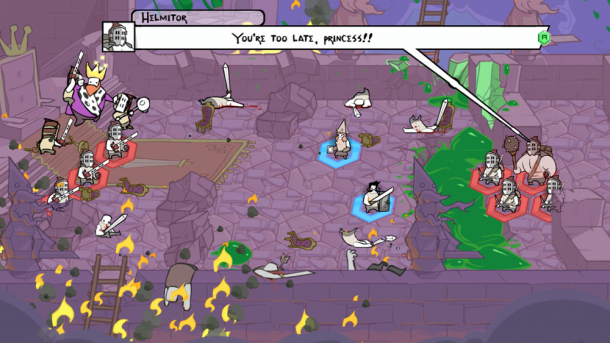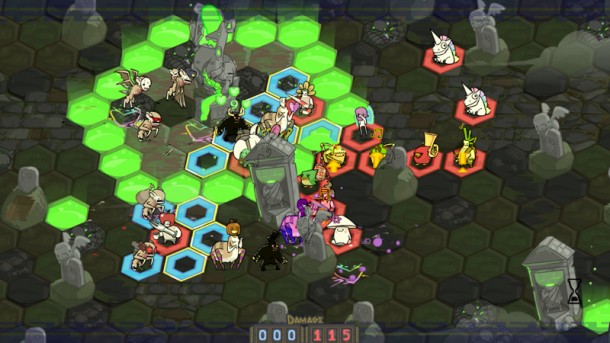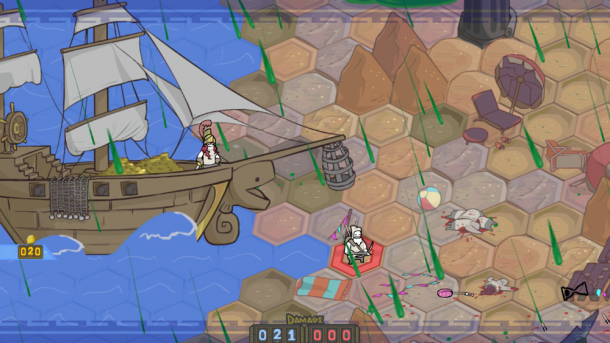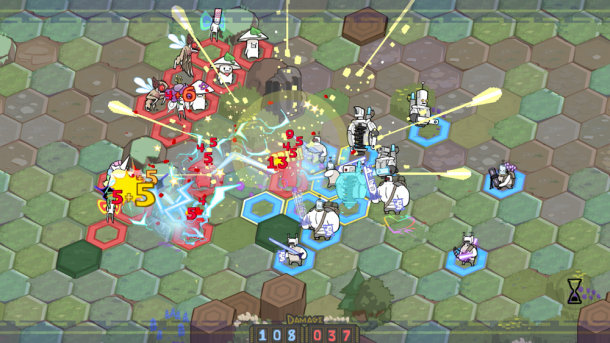After playing the demo for Game 4, I was able to grab an interview with The Behemoth’s Ryan Horn, level design guru. We chatted about game design, gameplay mechanics, and new features in the demo. Most intriguing, perhaps, are Ryan’s insightful comments about how past experiences have very much flavored the production of Game 4¸ allowing the Behemoth to approach their latest project with a clear vision and a transparent means of conducting business.
Robyn: What was different about designing the levels in Game 4 versus, say, BattleBlock Theater?
Ryan: BattleBlock Theater was different in that…I don’t want to say it was narrower, but it was more focused in terms of what you could do and how you could do it. With Game 4, there are tons of different hex types, different terrain types—a whole new variety of things we have to work with. It took some getting used to. On top of that, we’re doing terrain design as well as quest design and story design. Factoring those extra things in with the super wide variety that we have to work with is tough. Well, tough in that it was really exciting, but it also took some time to get some momentum going.
Robyn: What were some of the biggest challenges that you dealt with?
Ryan: Figuring out how to do questing well. In BattleBlock Theater there is a story arc, but each level doesn’t tell a specific story. With Game 4, we can have little sidequests that have their own little story, like the one you played with the swordfish. These are not directly connected to the main storyline, but they need to be contained within themselves as a good short story. We’ve been figuring out how to flesh those out enough to make them fun but not too long or “weighty,” so that they don’t take you away from the main story.
Robyn: What was a major inspiration behind transitioning from the platforming elements of BattleBlock Theater to Game 4’s more RPG, turn-based style?
Ryan: We like to change genres, and when we go into a new genre, we like to make it our own. We don’t think of Game 4 as a strategy game. We think of it as a fast-paced, turn-based co-op adventure game. I think that’s representative of our mindset; we want it to feel like a Behemoth game. To do that, and have it still be a different genre, we really need to take it from the ground up—one step at a time—and make each part of it feel like it’s ours. So, going into a new genre, we look at what’s out there, but we really want to find what’s fun for us.

Robyn: One thing that you brought up is this idea of “The Behemoth Game.” Anyone who’s played Castle Crashers or BattleBlock Theater knows exactly what that is. From the perspective of level design in particular, what would you characterize as a Behemoth Game?
Ryan: It’s difficult for me to talk about Castle Crashers, since I didn’t come on board until Battle Block Theater. We put a lot of time and effort into play testing all our stuff, and we make everything as accessible as we can while not sacrificing complexity and depth. From a level design standpoint, we think a lot about finesse. We block out parts that we want to hit and try to tie them into the story. That carries over into Game 4. We’re going to play test the heck out of it, and we want it to feel like it is totally natural and fun. The terrain shouldn’t get in your way. It should support the gameplay, support the story, and everything else that you’re doing. It provides a solid base platform for everything else to be built on.
Robyn: Good answer! I really liked the use of hexes, and you’ve already kind of mentioned them. I have a two-pronged question on that topic. Why hexes? And is there anything that you tried before that?
Ryan: I think that Dan [Paladin] just likes hexes.
[Everyone laughs]
Honestly, I couldn’t tell you exactly why. I think hexes are ideal because they allow multiple avenues of movement without letting it be completely free-movement. It gives you just enough guidance and control in term of movement options and gameplay options. If you’re in one hex, you can move to multiple other hexes. If it was square-based, you could only move up and over—that’s the extent of it, kind of like chess. With hexes, there’s so many different combinations that still give the player adequate guidance without making it a real-time strategy.
Robyn: What thought processes are behind the different character classes that you’ve developed? I know that you guys just announced vampires, and many people already knew about Gluten the Cupcake. Even in Game 4’s fantasy-based story, they are very unique.
Ryan: They are. A lot of that is Dan’s crazy fun ideas. You can see a lot of his personality and likes in that—it’s his brain child. I think that his art really brings those different characters to life, but we also wanted to not just have humans running around and hitting each other. We wanted to have different units that aren’t just visually different but mechanically different, so we can use those mechanics in game building.
When you play, you’ll probably want a cupcake to support your team. Maybe you want a vampire. I don’t know if you saw vampires, but they’re really interesting because they are like they sound. Their attack does damage and siphons off life, so they gain life when they do damage. On top of that, they do more damage and drain more life the more injured a unit is. So, vampires end up waiting in the wings of combat, trying to not get killed because they’re relatively weak. When the enemy team gets more and more injured, they sweep in and start picking people off. It’s really satisfying.
Instead of making different human characters with different abilities and equipment, I think it really spoke to our crazy-mindset to have vampires instead of, like, weapons. It also goes along with the storyline of the giant bear hitting the earth and warping space and time. It lends itself to the idea that everything’s gone haywire. Why wouldn’t a vampire and a robot be fighting each other?

Robyn: I saw a ton of classes in the gameplay reel after the demo, like robots, unicorns—all sorts of crazy things. How many classes are you guys planning at the moment?
Ryan: At the moment, we don’t even know!
[Everyone laughs]
In the demo, we have humans, giants, gnomes, pixies, robots, vampires, trolls, cupcakes. At least seven, right now. We’re still in development, so that may or may not change. We have a lot of ideas, so it’s exciting.
Robyn: I’ve asked you a lot of questions about what’s different about Game 4 versus your previous games, but playing it (and having played BattleBlock Theater), I noticed a lot of similar concepts and beats, particularly in the customization feature. So, what from your proverbial tool-kit was really useful in approaching Game 4 that you might’ve picked up from BattleBlock Theater?
Ryan: I think that we knew that we wanted to do more with Will Stamper and the aspects that he brings to everything. Also, in BattleBlock Theater, you could get all the different prisoners, but they don’t change the gameplay or the way you move. It’s fun to collect them, and they look great and are a lot of fun, but they don’t actually change the gameplay. In shifting to a turn-based hex-game, we wanted to bring that same customization but add to it. So, now you can have the helmets, the weapons, and the shields, but they do change gameplay. Helmets offer resistance, and weapons have different types of bonus damages. In Castle Crashers, you had tons of weapons and different characters, so we’ve always known that we like variety and giving the player choice. We like letting them just swim in our world of creativity.
With BattleBlock Theater, we learned that doing in-house usability testing is huge. We, as level designers, bring people in to playtest and watch them. Sometimes, we’ll be like “This is a rough spot in the level, let’s change that1” Doing that from the get-go with Game 4 is making the whole process a lot more streamlined and straightforward. We have the biggest team that we’ve ever had—more programmers, more level designers. It’s just the right size. Having extra people gives us the ability to do more of the things that we want.
So, I guess having a larger team of like-minded individuals, carrying over character customization, and bringing that in a way that allows the player to make decisions about the type of team they want.
Robyn: I was really impressed by how polished the game is currently, given that you don’t even have an official name yet.
Ryan: In the prototype stage, we took some time to nail down where we wanted to go and what we wanted to do with it. There’s still a bunch of questions hanging in the wings, but we know the direction we’re going, so now we just have to truck on to the end.
Robyn: Are there any major changes or additions that you’re anticipating, particularly after seeing it played so much at PAX?
Ryan: Between PAX Prime and now, we added more story to the intro tutorial and made it more exciting and dynamic. We added the cannon. When you’re in the world map running around from quest to quest, you’ll encounter random enemies that pop up and attack you when you get close enough. If you’re on a quest mission, you don’t want to do a random battle. You can shoot a cannonball at an enemy, and it stuns them for a little while so you can run by. That came from us realizing that the world map needed something more to do. The cannon adds a tactical aspect to moving around the world map, and it lets you choose whether or not you want to engage in random fights or dodge. Recruitment is a big one since PAX Prime. You saw that with Sofia recruiting Gluten. That was a lot of fun.

Robyn: That’s a really cool addition to make. Can that occur with any enemy type?
Ryan: Yeah. You can do it in a random battle; you can do it in a quest. You have to have a cage in your wagon and a party member with the net. It’s really cool because you can wander around to see what you see. If you see a unit that you really love, then the battle is no longer just about winning—it’s about winning tactically to get down to that one last unit that you want to capture. Once you recruit them, their exactly as you see them. If they have a cool piece of gear, you get to keep it. It’s pretty exciting to be able to flesh out your team like that.
Robyn: I was terrified that I’d accidentally hit Gluten instead of recruiting him, and I really changed my approach. So, I can see how it would change the tactics in a given scenario.
In terms of other kinds of tactical-thinking, I noticed that you’re continuing the tradition of having ratings at the end of each “stage.” Obviously, there would be a different scoring scale for the platforming aspects of BattleBlock Theater versus the turn-based aspects of Game 4. What sort of things went into streamlining the scoring system for a new genre?
Ryan: We totally redesigned it. We knew that we wanted to have a grading system—that’s another thing that’s different since PAX Prime. We added the battle rating system. We like giving the player feedback, and it’s not necessarily to be like “You suck! You didn’t do well! You should feel ashamed!” It’s more to give them positive feedback. There’s damage scale, a defense scale, and a utility scale (effectively healing), and that gives you a way to assess how well your team did and make changes based on that. Maybe you didn’t do as much damage as defense after combat, so you could change it. The ranking system can help with 2v2 multiplayer. That will be a thing. You can get your friends and have a good ole’ arena battle. It’s a lot of fun.
Robyn: So, you’ll have both cooperative and competitive aspects to it. I like that you have feedback cards around the demo space, too. Did these help you make the changes between the different PAX builds?
Ryan: Yeah! That goes towards the usability testing that I was talking about. One of the reasons we love coming to conventions is that it gives us a chance to let people play the game and get their feedback. We get to see their reactions, and that has a large influence on changes that we make. I don’t know if there are any specific suggestions on a comment card that enact changes, but it’s very interested getting feedback from players.

Robyn: You could say that the entire fanbase, to some extent, is participating in the testing process?
Ryan: Oh, yeah. Totally. The Research Centaur is now doing all the usability testing. We’re bringing the stuff that we learned from testing BattleBlock Theater and offering that to other indie companies. So, other developers can realize that they need usability testing and QA (quality assurance) testing, and we work with them to help them get that.
Robyn: It’s great that you’re sharing your resources with the indie community. I’m also glad you mentioned that you consider yourselves an indie company. What has been the biggest surprise in terms of reception? How has it felt to have this surge of support for Game 4?
Ryan: It’s so great. I mean, it was kind of a bummer to not have a new game or totally new stuff to show people when we were working on BattleBlock Theater. That’s not to say that we weren’t excited about it—we were—but six years is a long time to develop a game. It’s really nice to build this new thing and have all these new opportunities.
Robyn: I know it’s super early to ask, when is the anticipated or even hopeful launch?
Ryan: Honestly, we don’t even have a window. I wish I could give you one, but we want to make it awesome.
Robyn: Yeah, I can totally respect that.
Ryan: We want to be as absolutely happy with it as we can. If that takes six years (and I’m not saying it will), we’ll be excited for it. We really like to be transparent. We come to conventions to show everybody our ideas. We love talking to press about the game, and we want to show it off. We want to show our progress.

![An Interview with The Behemoth’s Ryan Horn [PAX East]](https://www.sidequesting.com/wp-content/uploads/Game4_TitleScreen.jpg)

No Comments